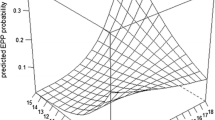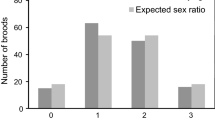Abstract
The “sexy son” hypothesis suggests that females obtain future fitness benefits from mating with polygynous males through the inheritance by their sons of traits contributing to mating success. We tested this hypothesis in the facultatively polygynous European starling (Sturnus vulgaris) in two ways. We first compared sons of monogynous and polygynous free-living males for their abilities in nest site acquisition and female-directed behaviors in controlled aviary tests. We then investigated eggs laid in monogynous and polygynous matings for concentrations of maternal steroid hormones that could affect behavioral differentiation of sons. Sons of polygynous fathers defended more nest boxes and produced more courtship song than sons of monogynous fathers. Mean concentrations of maternal androstenedione (A4), 5α-dihydrotestosterone (DHT), testosterone (T), and 17β-estradiol (E) in yolks were not affected by mating status. However, the within-clutch pattern of A4 depended on mating status, with higher concentrations in last than in first eggs of clutches of monogynous but not polygynous matings. These results suggest that (1) sons may inherit from their fathers behavioral qualities for the successful acquisition of nest sites and attraction of mates; (2) differential exposure to maternal steroid hormones during development in the egg is unlikely the cause of the behavioral differences between adult sons of monogynous and polygynous fathers; and (3) females adjust the within-clutch pattern of androgen to mating status, possibly in response to the expected contribution of their mate to nestling care.




Similar content being viewed by others
References
Alatalo RV, Gottlander K, Lundberg A (1988) Conflict or cooperation between parents in feeding nestlings in the pied flycatcher Ficedula hypoleuca. Ornis Scand 19:31–34
Alatalo RV, Rätti O (1995) Sexy son hypothesis: Controversial once more. Trends Ecol Evol 10:52–53
Bakker TM (1993) Positive genetic correlation between female preference and preferred male ornament in sticklebacks. Nature 363:255–257
Burley N (1988) The differential allocation hypothesis: An experimental test. Am Nat 132:611–628
Cunningham EJA, Russell AF (2000) Egg investment is influenced by male attractiveness in the mallard. Nature 404:74–77
Duffy D, Ball GF (2002) Song predicts immunocompetence in male European starlings (Sturnus vulgaris). Proc R Soc Lond B 269:847–852
Eens M, Pinxten R, Verheyen RF (1991) Male song as a cue for mate choice in the European starling. Behavior 116:210–238
Eens M, Pinxten R (1996) Female European starlings increase their copulation solicitation rate when faced with the risk of polygyny. Anim Behav 51:1141–1147
Eising CM, Eikenaar C, Schwabl H, Groothuis TGG (2001) Maternal androgens in Black-headed gull (Larus ridibundus) eggs: Consequences for chick development. Proc R Soc Lond B 266:765–770
Emlen S, Oring LW (1977) Ecology, sexual selection and the evolution of mating systems. Science 197:215–223
Eshel I, Volovik I, Sansone E (2000) On Fisher-Zahavi’s handicapped sexy son. Evol Ecol 2:509–523
Gil D, Graves J, Hazon N, Wells A (1999) Male attractiveness and differential testosterone investment in zebra finch eggs. Science 286:126–128
Hansson B, Bensch S, Hasselquist D (2000) Patterns of nest predation contribute to polygyny in the Great Reed Warbler. Ecology 81:319–328
Hasselquist D, Bensch S, v. Tschantz T (1996) Correlation between male song repertoire, extra-pair paternity and offspring survival in the great reed warbler. Nature 381:229–232
Houtman AM (1992) Female zebra finches choose extra-pair copulations with genetically attractive males. Proc R Soc Lond B 249:3–6
Johnson LS, Kermott LH, Lein MR (1993) The cost of polygyny in the house wren Troglodytes aedon. J Anim Ecol 62:669–682
Kempenaers B (1994) Polygyny in the blue tit: Unbalanced sex ratio and female aggression restrict mate choice. Anim Behav 47:943–957
Kirkpatrick M (1985) Evolution of female choice and male parental investment in polygynous species: The demise of the “sexy son”. Am Nat 125:788–810
Mountjoy J, Lemon RE (1996) Female choice for complex song in the European starling: A field experiment. Behav Ecol Sociobiol 38:65–71
Norris KJ (1990) Female choice and the evolution of the conspicuous plumage coloration of monogynous male great tits. Behav Ecol Sociobiol 26:129–138
Orians GH (1969) On the evolution of mating systems in birds and mammals. Am Nat 103:589–603
Petrie M (1992) Copulation frequency in birds: Why do females copulate more than once with the same male? Anim Behav 44:790–792
Petrie M (1994) Improved growth and survival of offspring of peacocks with more elaborate trains. Nature 371:598–599
Pilz KM, Smith HG, Sandell MI, Schwabl H (2003) Inter-female variation in egg yolk androgen allocation in the European starling: Do high quality females invest more? Anim Behav 65:841–850
Pilz KM, Quiroga M, Schwabl H, Adkins-Regan E (2004) European starling chicks benefit from high yolk testosterone during a drought year. Horm Behav 46:179–192
Pinxten R, Eens M (1990) Polygyny in the European starling: Effect of female reproductive success. Anim Behav 40:1035–1047
Pinxten R, Havotte O, Eens M, Verheyen R, Dhondt A, Burke T (1993) Extrapair paternity and interspecific brood parasitism in the European starling, Sturnus vulgaris. Anim Behav 45:795–809
Pinxten R, Eens M (1994) Male feeding of nestlings in the facultatively polygynous European starling: Allocation patterns and effect on female reproductive success. Behavior 129:113–114
Pomiankowski A, Iwasa Y, Nee S (1991) The evolution of costly mate preferences I. Fisher and the biased mutation. Evolution 45:1422–1430
Pribil S, Searcy W (2001) Experimental confirmation of the polygyny threshold model for red-winged blackbirds. Proc R Soc Lond B 268:1643–1646
Sandell M Smith HG, Bruuns M (1996) Paternal care in the European starling. Sturnus vulgaris: Nestling provisioning
Sandell MI, Smith HG (1997) Female aggression in the European starling during the breeding season. Anim Behav 53:13–23
Schwabl H (1993) Yolk is a source of maternal testosterone for developing birds. Proc Natl Acad Sci USA 90:11446–11450
Schwabl H (1996) Maternal testosterone in the avian egg enhances post-natal growth. Comp Biochem Physiol 114 A:271–276
Schwabl H, Mock D, Gieg J (1997) A hormonal mechanism for parental favouritism. Nature 386:231
Searcy WA, Yasukawa K (1989) Alternative models of territorial polygyny in birds. Am Nat 134:323–343
Searcy WA, Eriksson D, Lundberg A (1991) Deceptive behavior in pied flycatchers Ficedula hypoleuca. Behav Ecol Sociobiol 29:167–175
Sheldon B (2000) Differential allocation: Tests, mechanisms and implications. TREE 15:397–402
Slagsvold T, Drevon T (1999a) Female pied flycatchers trade between male qualitiy and mating status in mate choice. Proc R Soc Lond B 266:917–921
Slagsvold T, Dale S, Lampe HM (1999b) Does female aggression prevent polygyny? An experiment with pied flycatchers (Ficedula hypoleuca). Behav Ecol Sociobiol 45:403–410
Smith HG, Ottosson U, Sandell M (1994) Intrasexual competition among polygynously mated female starlings (Sturnus vulgaris). Behav Ecol 5:57–63
Slagsvold T, Lifjeld JT (1994) Polygyny in birds: The role of competition between females for male parental care. Am Nat 143:59–94
Smith HG, v. Schantz T (1993) Extra pair paternity in the European starling. The effect of polygyny. Condor 95:1006–1015
Sockman KS, Schwabl H (2000) Yolk androgens reduce offspring survival. Proc R Soc London B 267:1451–1456
Strasser R, Schwabl H (2004) Yolk testosterone organizes behavior and male plumage coloration in house sparrows (Passer domesticus). Behav Ecol Sociobiol 56:491–497
Stenmark G, Slagsvold T, Lifjeld JT (1988) Polygyny in the pied flycatcher Ficedula hypoleuca: A test of the deception hypothesis. Anim Behav 36:1646–1657
Verner J (1964) The evolution of polygyny in the long-billed marsh wren. Evolution 18:252–261
Wagner RH (1994) Mixed mating strategies by females weaken the sexy son hypothesis. Anim Behav 47:1207–1209
Weatherhead PJ, Robertson RJ (1979) Offspring quality and the polygyny threshold: “The sexy son hypothesis”. Am Nat 113:201–208
Weatherhead PJ, Robertson RJ (1981) In defense of the “sexy son” hypothesis. Am Nat 117:349–356
Weatherhead PJ (1994) Mixed mating strategies by females may strengthen the sexy son hypothesis. Anim Behav 47:1210–1211
Wedell N, Tregenza T (1999) Successful fathers sire successful sons. Evolution 53:620–625
Wittenberger JF (1981) Male quality and polygyny: The “sexy son” hypothesis revisited. Am Nat 117:329–342
Acknowledgement
We are very grateful to E. Gwinner for many valuable discussions and his general support. B. Kempenaers, B. Helm, the Associate editor W. Searcy and two referees provided productive comments on earlier versions of the manuscript. F. Merkel helped regarding various aspects of starling life history. J. Schuller, K. Etzold, Ch. Clapier and J. Jäger assisted in the field and in data processing
Author information
Authors and Affiliations
Corresponding author
Additional information
Communicated by W.A. Searcy
Rights and permissions
About this article
Cite this article
Gwinner, H., Schwabl, H. Evidence for sexy sons in European starlings (Sturnus vulgaris). Behav Ecol Sociobiol 58, 375–382 (2005). https://doi.org/10.1007/s00265-005-0948-0
Received:
Revised:
Accepted:
Published:
Issue Date:
DOI: https://doi.org/10.1007/s00265-005-0948-0




